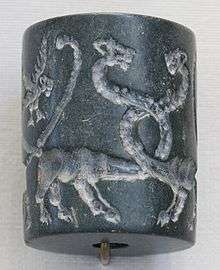Music of Mesopotamia
This article treats the music of Ancient Mesopotamia.
Cuneiform sources reveal an orderly organized system of diatonic scales, depending on the tuning of stringed instruments in alternating fifths and fourths. Whether this reflects all types of music is not known.
Instruments
Instruments of Ancient Mesopotamia include harps, lyres, lutes, reed pipes, and drums. Many of these were shared with neighbouring cultures. Contemporary East African lyres and West African lutes preserve many features of Mesopotamian instruments (van der Merwe 1989, p. 10).
The vocal tone or timbre was probably similar to the pungently nasal sound of the narrow-bore reed pipes, and most likely shared the contemporary "typically" Asian vocal quality and techniques, including little dynamic changes and more graces, shakes, mordents, glides and microtonal inflections. Singers probably expressed intense and withdrawn emotion, as if listening to themselves, as shown by the practice of cupping a hand to the ear (as is still current in modern Assyrian music and many Arab and folk musics) (van der Merwe 1989, p. 11).
Two badly damaged silver pipes have been excavated from a grave at Ur and dated to c. 2500 BCE. The pipes were crafted with what appear to be finger holes, and it is believed that they formed a pair of tubes - "double-pipes" - that had reeds inserted. A number of reconstructions have been proposed, the most recent being a pair of thin tubes with three finger holes in one tube and four finger holes in the other (Goss 2012).
See also
| Wikimedia Commons has media related to Music of Mesopotamia. |
Sources
- Goss, Clint (2012). "Flutes of Gilgamesh and Ancient Mesopotamia". Flutopedia. Retrieved 2012-01-08.
- Irvine, Douglas (2003). "The Gold Lyre of Ur, c. 2650 BC (BCE)". WilliamSound.com (Accessed 19 January 2011).
- Roger, Peter, and Stuart Moorey (1976). Ancient Iraq: (Assyria and Babylonia). Oxford: Ashmolean Museum.
- van der Merwe, Peter (1989). Origins of the Popular Style: The Antecedents of Twentieth-Century Popular Music. Oxford: Clarendon Press. ISBN 0-19-316121-4.
Further reading
- Duchesne-Guillemin, Marcelle (1980). "Sur la restitution de la musique hourrite". Revue de Musicologie 66, no. 1 (1980): 5–26.
- Duchesne-Guillemin, Marcelle (1984). A Hurrian Musical Score from Ugarit: The Discovery of Mesopotamian Music, Sources from the Ancient Near East, vol. 2, fasc. 2. Malibu, CA: Undena Publications. ISBN 0-89003-158-4
- Fink, Robert (1981). The Origin of Music: A Theory of the Universal Development of Music. Saskatoon: Greenwich-Meridian.
- Gütterbock, Hans (1970). "Musical Notation in Ugarit". Revue d'assyriologie et d'archéologie orientale 64, no. 1 (1970): 45–52.
- Kilmer, Anne Draffkorn (1971). The Discovery of an Ancient Mesopotamian Theory of Music. Proceedings of the American Philosophical Society 115:131–49.
- Kilmer, Anne Draffkorn (1974). "The Cult Song with Music from Ancient Ugarit: Another Interpretation". Revue d'Assyriologie 68:69–82.
- Kilmer, Anne Draffkorn (1997). "Musik, A: philologisch". Reallexikon der Assyriologie und vorderasiatischen Archäologie 8, edited by Dietz Otto Edzard, 463–82. Berlin: De Gruyter. ISBN 3-11-014809-9.
- Kilmer, Anne (2001). "Mesopotamia §8(ii)". The New Grove Dictionary of Music and Musicians, second edition, edited by Stanley Sadie and John Tyrrell. London: Macmillan Publishers.
- Kilmer, Anne Draffkorn, Richard L. Crocker, and Robert R. Brown (1976). Sounds from Silence: Recent Discoveries in Ancient Near Eastern Music. Berkeley: Bit Enki Publications, 1976. Includes LP record, Bit Enki Records BTNK 101, reissued [s.d.] as CD.
- Vitale, Raoul (1982). "La Musique suméro-accadienne: gamme et notation musicale". Ugarit-Forschungen 14 (1982): 241–63.
- Wellesz, Egon, ed. (1957). New Oxford History of Music Volume I: Ancient and Oriental Music. Oxford: Oxford University Press.
- West, M[artin]. L[itchfiel]. (1994). "The Babylonian Musical Notation and the Hurrian Melodic Texts". Music and Letters 75, no. 2 (May): 161–79.
- Wulstan, David (1968). "The Tuning of the Babylonian Harp". Iraq 30:215–28.
- Wulstan, David (1971). "The Earliest Musical Notation". Music and Letters 52 (1971): 365–82.
